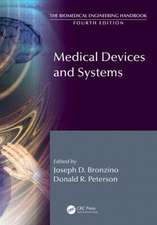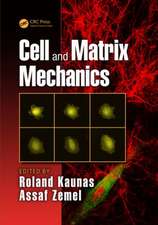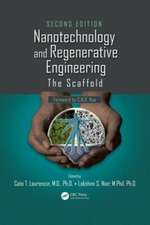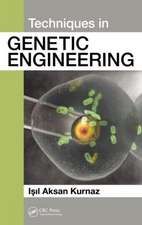Synthetic Biology: Omics Tools and Their Applications
Editat de Shailza Singhen Limba Engleză Paperback – 25 dec 2018
The chapters discuss how the principles of engineering are being used in biomedical sciences, to design biological circuits that can harbor multiple inputs and generate multiple outputs; to create genetic networks and control gene activity, in order to generate a desired response. The book aims to help the readers develop an array of biological parts, and to use these parts to develop synthetic circuits that can be assembled like electronic circuits. The ultimate aim of the book will be to serve as an amalgamation of key ideas of how judiciously synthetic biology could be exploited in therapeutic device and delivery mechanism.
| Toate formatele și edițiile | Preț | Express |
|---|---|---|
| Paperback (1) | 557.75 lei 39-44 zile | |
| Springer Nature Singapore – 25 dec 2018 | 557.75 lei 39-44 zile | |
| Hardback (1) | 646.62 lei 3-5 săpt. | |
| Springer Nature Singapore – 12 oct 2018 | 646.62 lei 3-5 săpt. |
Preț: 557.75 lei
Preț vechi: 697.19 lei
-20% Nou
Puncte Express: 837
Preț estimativ în valută:
106.73€ • 111.66$ • 88.66£
106.73€ • 111.66$ • 88.66£
Carte tipărită la comandă
Livrare economică 31 martie-05 aprilie
Preluare comenzi: 021 569.72.76
Specificații
ISBN-13: 9789811342165
ISBN-10: 9811342164
Pagini: 259
Ilustrații: VII, 259 p. 60 illus., 55 illus. in color.
Dimensiuni: 155 x 235 mm
Ediția:Softcover reprint of the original 1st ed. 2018
Editura: Springer Nature Singapore
Colecția Springer
Locul publicării:Singapore, Singapore
ISBN-10: 9811342164
Pagini: 259
Ilustrații: VII, 259 p. 60 illus., 55 illus. in color.
Dimensiuni: 155 x 235 mm
Ediția:Softcover reprint of the original 1st ed. 2018
Editura: Springer Nature Singapore
Colecția Springer
Locul publicării:Singapore, Singapore
Cuprins
Chapter 1. Integrated Systems and Chemical biology approaches for targeted therapies.- Chapter 2. Application of bioengineering in revamping human health.- Chapter 3. Integrative Omics for Interactomes.- Chapter 4. Studying parasite gene function and interaction through ribozymes and riboswitches design mechanism.- Chapter 5. Genome microbiology for Synthetic applications.- Chapter 6. Medicinal Application of Synthetic Biology.- Chapter 7. Computational tools for applying multi-level models to Synthetic Biology.- Chapter 8. Computational techniques for a comprehensive understanding of different genotype-phenotype factors in biological systems and their applications.- Chapter 9. Alignment-free analyses of nucleic acid sequences using graphical representation.- Chapter 10. Modern Approaches in Synthetic Biology: Genome Editing,Quorum Sensing and Microbiome Engineering.- Chapter 11. Synthetic Probes, their applications & designing.- Chapter 12. Omics Based Nanomedicine.- Chapter 13. Characterization of plant genetic modifications using Next Generation Sequencing.
Notă biografică
Shailza Singh is working as Scientist D at National Centre for Cell Science, Pune. She works in the field of Computational and Systems Biology wherein she is trying to integrate the action of regulatory circuits, cross-talk between pathways and the non-linear kinetics of biochemical processes through mathematical models. The current thrust in her laboratory is to explore the possibility of network-based drug design and how rationalized therapies may benefit from Systems Biology. She has published a book with Springer, titled 'Systems Biology Application in Synthetic Biology'. She is the recipient of RGYI (DBT), DST-Young Scientist and INSA (Bilateral Exchange Programme). She is the reviewer of various international and national grants funded from government organizations.
Textul de pe ultima copertă
The book uses an integrated approach to predict the behavior of various biological interactions. It further discusses how synthetic biology gathers the information about various systems, in order to either devise an entirely new system, or, to modulate existing systems. The book also tackles the concept of modularity, where biological systems are visualized in terms of their parts.
The chapters discuss how the principles of engineering are being used in biomedical sciences, to design biological circuits that can harbor multiple inputs and generate multiple outputs; to create genetic networks and control gene activity, in order to generate a desired response. The book aims to help the readers develop an array of biological parts, and to use these parts to develop synthetic circuits that can be assembled like electronic circuits. The ultimate aim of the book will be to serve as an amalgamation of key ideas of how judiciously synthetic biology could be exploited in therapeutic device and delivery mechanism.
Caracteristici
Discusses the concepts of synthetic and systems biology in a comprehensive yet lucid manner Presents the latest applications of synthetic biology in different areas of biology Gives insights into methods to handle and use the massive Omics data


















